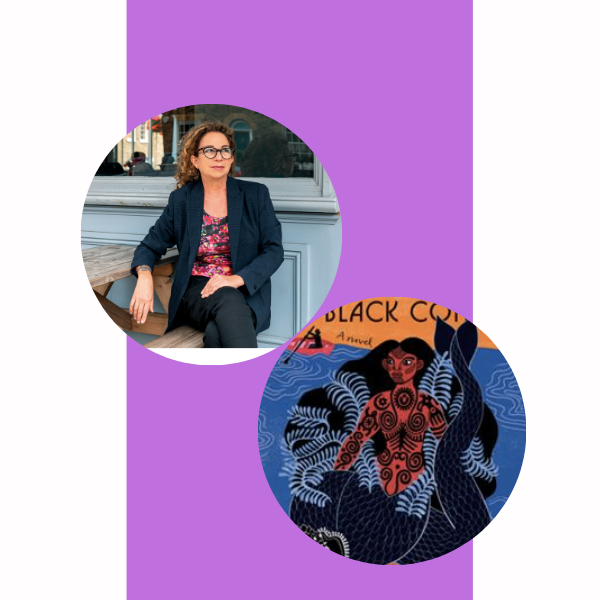In Monique Roffey’s The Mermaid of Black Conch, set in 1976, protagonist David is fishing off the island of Black Conch when he finds a mermaid named Aycayia. She was a beautiful woman cursed by jealous wives. David rescues her, discovering she can transform back into a woman when she is out of water. David works to earn Aycayia’s trust as she heals and survives on land.
My initial interest in the book was in the fact that it sounded like an alternative to The Little Mermaid. Aycayia was given the agency to love herself amidst trusting a man. I interviewed Roffey about the novel, and we talked about everything from writing about Aycayia who is objectified to the occupation of the land to what she learned about herself as a writer.
The story is powerful, imaginative, and deeply poetic.
Thank you, Monique Roffey, for answering questions about The Mermaid of Black Conch.
What is your definition of feminism?
A necessary woman-centered consciousness and activism… a struggle for equality for women. Women have been so badly treated, and endured a lack of equal rights, for millennia (especially since God became male around 2,000 years ago). In the 20th century, four of five waves of activism changed our status. But a hundred years isn’t long in the timeline of humanity. The struggle must never wane. Women are still seen as weaker, intellectually and emotionally, and our fight for equality is ongoing.
Why did you choose 1976 and 2015-2016 as the times for this story?
Nineteen seventy-six, the mid-’70s, was an era of radicalism and nation building and black power in the Caribbean, a good time for a woman who used to be a mermaid to come back. Also, it’s pre-the digital era, so no one would have filmed her being caught and broken the Internet. Twenty-fifteen through sixteen was when I started to write this book. David is writing 40 years later as an old man; I did the math. That’s about 40 years from the ’70s.
You write about the occupation of the land where the story takes place. What did you want to inform readers about this?
Aycayia comes from a different time, long before mass industrial agriculture and ownership of land. Miss Rain owns most of Black Conch in the modern, post-Empire times. But Aycayia makes the point to her that no one can own the land. She is wise and has a shamanic understanding of the laws of the universe. The book yearns for an Eden-ic time, when humanity respected the natural world and we were more in sync.

Aycayia is objectified. She is also admired and learns about multiple worlds. Who did you want her to become?
My aim was for her to beat the curse put upon her, and she does. She was cursed into exile and her sexuality was sealed up inside a giant tail. In this book, she becomes part of a community and meets Eros in the form of David and enjoys her erotic rite of passage from virgin into lover. She goes back to the sea differently. She and David continue to meet. She will never be so lonely again.
What did you learn about yourself, particularly regarding your imagination, while writing this story?
I didn’t do much research for this book. Looking back, my unconscious had been taking note of a couple of parts of Trinidad and it had been soaking up life there, dreaming up ideas and doing a lot of thinking for me, over years. I had a vivid mermaid dream in 2013, in Tobago, during a fishing competition… so for some time my “back brain” had been growing a story. That’s what I learned about writing this book: how story emanates from an unconscious story-making… myth-making part of the human psyche. I dreamt this book up, slowly; then I wrote it.
What organization would you like to amplify to our readers?
Turtle Village Trust, in Grande Riviere, Trinidad. It’s a small conservation trust that aims to keep the huge leatherback nesting site safe on this part of the north coast of Trinidad. They organize tours, release hatchlings, and tag and monitor the thousands of female leatherbacks that come to lay their eggs on this beach year after year. Grand Riviere is home to one of the world’s largest leatherback turtle nesting sites.


![This April we're diving into Muslim voices with some pretty incredible titles✨️
This members will also receive a sticker from @marhabaprints! Marhaba Prints is a South Asian and Islamic inspired online stationary store selling greeting cards, notepads, stickers, and more, that aims to be a bridge between Pakistani heritage, Islamic teachings, and Canadian culture.
As always we'll be discussing these titles in our online community! Join by April 9th to get one of these titles in your mailbox!
Learn more by heading to the link in our bio!
[alt text: three slides showcasing six books including: Hijab Butch Blue by Lamya H, All My Rage by Sabaa Tahir, Read Dangerously by Azar Nafisi, Read This to Get Smarter by Blair Imani, We Hunt the Flame by Hafsah Faizal, and You Exist Too Much by Zaina Arafat.]](https://www.feministbookclub.com/wp-content/plugins/instagram-feed/img/placeholder.png)